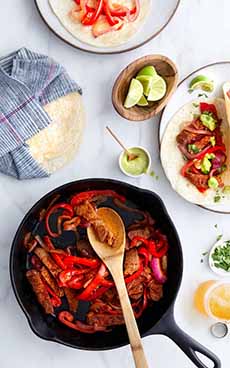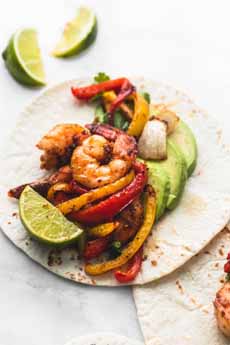RECIPES: Pork Fajitas With Apple Salsa & National Fajita Day
|
|
Peach salsa is one of the best-selling salsa flavors. But if you like to make your own salsa, summer peach season is a ways off. Mangoes are a delicious replacement; but how about apple salsa? Crisp apples provide some crunch in the salsa, and apple salsa is delicious with pork dishes and chicken dishes. Try this recipe, courtesy of the U.S. Apple Association. We also added julienned apple slices into the green salad we served on the side. If you don’t want to use pork, substitute steak or chicken. August 18th is National Fajita Day. > The history of fajitas is below. Yield: 4 servings, 2 fajitas each. Prep & Cook Time: 2 hours 15 minutes (includes chilling and marinating time). Apple Salsa Ingredients (2-1/2 Cups) Combine in a small bowl and mix well: 1. Combine. Place all salsa ingredients in a bowl and mix well. Cover and refrigerate for several hours to meld flavors. 2. Marinate. Place pork in a large sealable plastic bag and pour in the marinade. Cover and refrigerate for 1-1/2 hours or more, turning occasionally. 3. Preheat grill. Drain marinated pork, saving excess marinade. Place pork on the grill and brush with leftover marinade. Grill over hot coals, turning frequently, for 8-10 minutes, until an internal thermometer reads 155-160°F. Remove from heat and place on a clean plate. 4. Warm. Wrap tortillas tightly in foil and heat on upper grill rack for 10 minutes. 5. Assemble. Cut pork diagonally across grain into thin slices. Arrange one-eighth of pork slices and 2 or 3 tablespoons salsa in the center of the tortilla. Fold the bottom half of the tortilla over filling and overlap sides on top. Arrange on serving plate. Garnish as desired. Serve with a side of brown rice and beans. |
|
|
THE HISTORY OF FAJITAS A popular Tex-Mex dish, fajitas were created at the end of the 1930s and beginning of the 1940s, by Mexican ranch workers in south and west Texas. During cattle roundups, animals were butchered regularly to feed the hands. Throwaway items such as the hide, the head, the entrails, and meat trimmings such as the skirt were given to the Mexican cowboys (called vaqueros) as part of their pay. Hearty border dishes were created by the chuck wagon cooks: barbacoa de cabeza (head barbecue), menudo (tripe stew), and fajitas or arracheras (grilled skirt steak). Given the limited number of skirts per carcass, the cut was not available commercially. Thus, fajitas on the grill remained regional and relatively obscure for many years, likely familiar only to the vaqueros, local butchers, and their families [source]. These are just two narrow skirts per cow, about 20 to 24 inches long and three to four inches wide once they’ve been trimmed [source]. The word fajita has its origin in the Spanish “faja,” girdle. It referred to the little strips of meat cut from the beef skirt steak. The dish has evolved to include not just skirt steak but sirloin, chicken, seafood, and later, grilled vegetable Fajitas. It became a backyard and campfire staple, and ended up on Tex/Mex restaurant menus in the 1960s. At restaurants it is typically served on a sizzling hot metal plate with grilled bell peppers and onions. |
||






